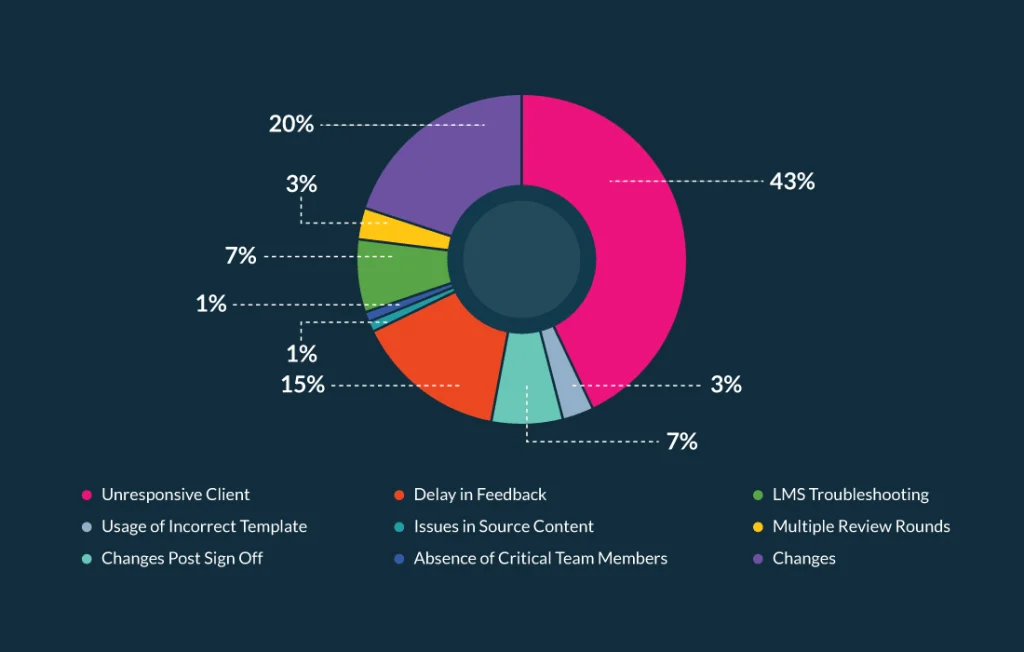
3 Reasons Why Learning Content Takes Forever to Develop
Despite corporate learning becoming a $462.6 billion industry by 2027, most L&D teams still struggle with one persistent challenge: learning content takes longer to develop than expected.
The business case for high-quality training content development is clear. Every dollar invested in online training yields approximately $30 in increased productivity. In fact, 42% of companies link eLearning implementation directly to increased revenue.
Yet the very learning content that fuels these returns often stays stuck in development cycles for months.
After examining industry research and expert insights, we’ve identified three major reasons why learning content development is so time-consuming. Understanding these is the first step toward building smarter, faster, and more effective content development strategies.
1. When “Engaging” Learning Content Becomes “Overwhelming”
Learner Expectations Are Changing
The era of static PowerPoint-based training is over. Today’s learners expect interactive, mobile-optimized, and highly personalized experiences. This evolution has significantly increased the complexity of custom content development.
According to research:
- Basic eLearning requires ~87 minutes of development time per finished minute.
- Add interactivity (drag-and-drop, scenarios), and it jumps to 197 minutes.
- Advanced simulations can take up to 466 minutes per finished minute of learning content.
This complexity is not a failure, it’s the cost of building engaging content design experiences that truly support learner needs.
Scenario-Based Learning Content Demands More
Scenario-based learning is proven to improve decision-making skills. But it also requires:
- Crafting compelling narratives
- Building multiple branching paths
- Creating meaningful feedback loops
Each scenario demands custom content development - relatable characters, plausible outcomes, and realistic consequences that teach something valuable.
Personalization Adds Layers of Content
A frontline retail worker needs different training content than a mid-level IT professional. Personalizing for different learner personas means developing learning content for diverse needs - a process that starts with deep analysis and careful planning.
Accessibility and Mobile Optimization Extend Timelines
Ensuring that training content is fully accessible and responsive across devices is essential, not optional. It adds time, but without it, content fails large segments of your workforce.
2. The Human Bottleneck in Learning Content Development
Even with solid content design, development can stall due to human and process breakdowns.
SME and Stakeholder Availability is Limited
According to the Association for Talent Development, lack of SME availability is one of the top three barriers to fast development.
SMEs are busy and L&D is rarely their top priority. When their input is delayed or inconsistent, it slows everything down.
SMEs May Not Understand Content Development
SMEs often lack knowledge of instructional design principles. What feels like a small ask (“just add this”) might mean hours of additional training content development work. Misaligned expectations create miscommunication and inefficiencies.
Common pain points include:
- Conflicting feedback from multiple reviewers
- Slow turnaround times
- Misunderstandings around scope
- Resistance to simplifying complex information
Industry research shows that a 10% scope increase can inflate project costs by 30%. Scope creep is real and expensive.
Ineffective Review Cycles Multiply Delays
“Design by committee” is a development killer. Too many reviewers or unclear decision-making structures lead to circular revisions.
Resource Constraints Make Everything Harder
About 67% of L&D professionals cite insufficient time, staff, or budget as major blockers. Juggling multiple projects with limited teams only exacerbates existing delays in content development.
3. The Strategy Gap in Learning Content Development
Perhaps the most overlooked factor in slow learning content development is poor planning.
Weak Instructional Strategy = Wasted Time
Without a clear understanding of:
- Learner needs
- Skill gaps
- Business goals
...teams end up creating learning content that misses the mark. Vague objectives lead to endless revisions and content that fails to resonate.
“L&D isn’t just about content generation. It involves assessing learner needs.”
No Business Alignment, No Direction
Without upfront alignment between training and business objectives, content quickly becomes irrelevant or off-target - triggering further changes mid-development.
Learning is About Behavior Change, Not Just Knowledge
Effective training content development must drive behavior change. This means:
- Realistic simulations
- Practice opportunities
- Measurable outcomes
All of which require advanced instructional strategies and increase content complexity especially at a global scale.
Localization Is an Afterthought (When It Shouldn’t Be)
Many global organizations develop content in a single language first, then localize. This often requires major rework.
Those using global-first strategies accounting for localization and cultural context early cut localization timelines by 25–50%.

How a Hybrid Agile-Waterfall Model Accelerates Learning Content Development
For L&D teams looking to overcome the complexity of learning content development, a hybrid Agile-Waterfall model can significantly speed up delivery while maintaining quality.
Why Pure Agile or Waterfall Alone Doesn’t Work for Learning Content
Traditional Waterfall models are linear and rigid great for software but not ideal for creative content design. Agile offers speed and adaptability but can lack structure. Since learning content blends creativity with structure, neither method alone fits well.
"Learning content is not code. The creative nuances in content development often require flexibility that traditional models can't support."
The Hybrid Approach in Action
Organizations are increasingly adopting a hybrid model that borrows from both frameworks combining the structured planning of Waterfall with the iterative flexibility of Agile.
Here’s how it works:
- Design reviews become sprints: Instead of waiting weeks for consolidated feedback, walkthroughs are done live, enabling real-time changes.
- Parallel workflows: Storyboarding and media development happen simultaneously, reducing production time.
- Modular content structure: Storyboards are broken into smaller parts using visual tools, accelerating review cycles.
- Built-in SME planning: SME availability is scheduled upfront, reducing bottlenecks from late-stage input.
- Early testing: Tasks like SCORM testing are shifted earlier in the process to smoothen final releases.
Results That Matter
In one case, adopting a hybrid model helped reduce the learning content development cycle from 12–14 weeks to just 8 weeks - a 30% reduction in time without compromising quality or complexity.
By incrementally delivering components, teams also reduce client wait times and increase collaboration — turning stakeholders into partners, not just reviewers.
Learning Content Development Will Always Take Time But It Doesn’t Have to Take Forever
Developing engaging, impactful learning content is inherently complex. But it doesn’t have to be chaotic.
By understanding and addressing the real reasons behind delays from rising learner expectations to poor stakeholder collaboration, weak strategy, and outdated development models, L&D teams can create faster, more efficient content development strategies.
Adopting a hybrid agile-waterfall approach allows organizations to combine structure with flexibility, speeding up delivery while maintaining high standards in content design.
Investing in the right methodology, tools, and upfront planning can shorten timelines without sacrificing quality - enabling learning content that drives behavior change, supports business goals, and meets learners where they are.